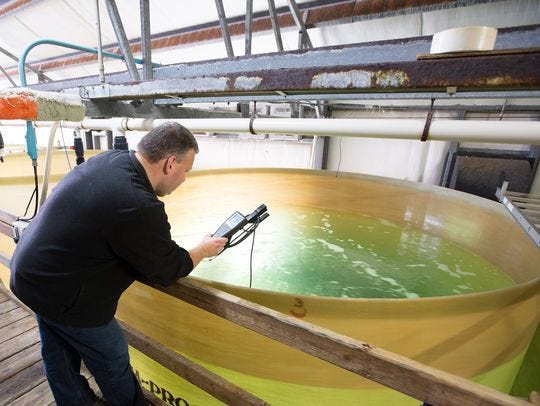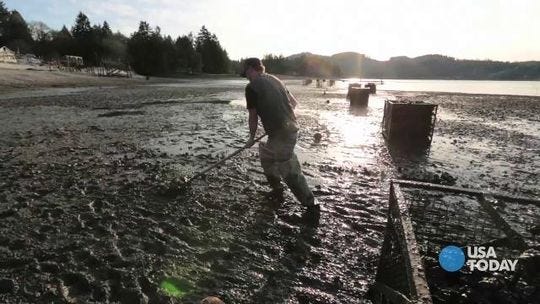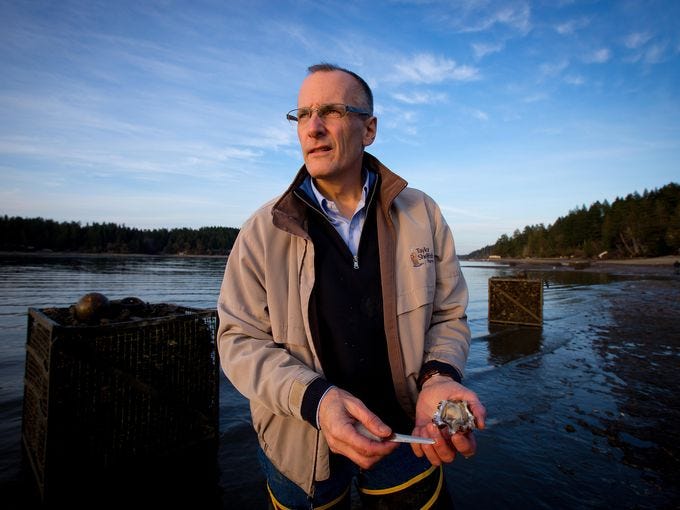Posted on USA Today: 28 Mar 2013 — By Dan Vargano
Read this and related articles and watch the video on USA Today
OYSTER BAY, Wash. — The tide rolls out on a chilly March evening, and the oystermen roll in, steel rakes in hand, hip boots crunching on the gravel beneath a starry, velvet sky.
As they prepare to harvest some of the sweetest shellfish on the planet, a danger lurks beyond the shore that will eventually threaten clams, mussels, everything with a shell or that eats something with a shell. The entire food chain could be affected. That means fish, fishermen and, perhaps, you.
“Ocean acidification,” the shifting of the ocean’s water toward the acidic side of its chemical balance, has been driven by climate change and has brought increasingly corrosive seawater to the surface along the West Coast and the inlets of Puget Sound, a center of the $111 million shellfish industry in the Pacific Northwest.
USA TODAY traveled to the tendrils of Oyster Bay as the second stop in a year-long series to explore places where climate change is already affecting lives.
The acidification taking place here guarantees the same for the rest of the world’s oceans in the years ahead. This isn’t the kind of acid that burns holes in chemist’s shirt sleeves; ocean water is actually slightly alkaline. But since the start of the industrial revolution, the world’s oceans have grown nearly 30% more acidic, according to a 2009 Scientific Committee on Oceanic Resources report. Why? Climate change, where heat-trapping carbon dioxide emitted into the air by burning coal, oil and other fossil fuels ends up as excess carbonic acid absorbed into the ocean.
“As fresh as they get, you could eat one now,” says Dewey of Taylor Shellfish Farms in Shelton, Wash., shucking an oyster open, mud running from its shell to reveal the opulent meat within, silver and white in the starlight. The black lip curling around the sweet-tasting shellfish reveals it to be a Pacific oyster, farmed worldwide.That shift hurts creatures like oysters that build shells or fish that eat those creatures or folks like shellfish farmer Bill Dewey, who makes his living off the ocean.
“Folks think we just get rich picking oysters off the ground. A lot of work goes into every one of these, and we can’t afford to lose any of them,” Dewey says.
Lose them they have, and lose them they will, to the water lapping at Dewey’s hip boots where the low tide meets the flats.
“We are looking into the future happening now,” Dewey says. And researchers are seeing similar corrosive effects on Florida’s coral reefs that shelter young fish and on the tiny sea snails that feed salmon and other species in the Pacific Ocean.
Too much of ‘a good thing’
Because of ocean chemistry, water three times more acidic resides at greater ocean depths. When conditions are right, strong winds blowing over ocean water along steep coasts, such as along the West Coast of North America, generate “upwelling” of these deep waters. The results bring this more corrosive seawater to the shallows of places such as Puget Sound, a foreshadowing today of how the oceans will look in a few decades.
“We are able to see the effects of ocean acidification,” says oceanographer Richard Feely of the National Oceanic and Atmospheric Administration. He first charted upwelling of deeper, corrosive ocean water on the surface of the Pacific Ocean along the West Coast on a 2007 expedition.
How did it get there in the first place? Atmospheric carbon ends up absorbed directly by the ocean, where plankton sucks up carbon dioxide via photosynthesis. “That’s a good thing,” Feely says, because the carbon dioxide they ingest means less warming of the atmosphere.
But when those sea plants and creatures die, they fall to the depths. Some of the consumed carbon ends up dissolved in deep ocean waters.
“Once we had the canary in the coal mine; now we have the oyster in the ocean,” Washington Gov. Jay Inslee says.
An oyster mystery
In the same year that Feely and his colleagues made their upwelling discovery, disaster struck the Whiskey Creek Shellfish Hatchery in Netarts Bay, perched on the edge of Oregon’s Pacific Coast. Baby oysters grown there to be shipped to shellfish farms worldwide were dying en masse, tens of millions of millimeter-size larvae filling hatching tanks, all dead.
“We were very close to going out of business. It was a major deal,” says Sue Cudd of the Whiskey Creek hatchery. Bankruptcy threatened because of unfilled orders, and the entire industry faced collapse without the larvae, the seeds that shellfish growers needed to raise Pacific oysters over the next 18 months. A second hatchery run by Dewey’s employers, Taylor Shellfish — one of four in the region — saw the same die-off the next year, with the same failure to spawn striking wild oysters in Washington’s Willapa Bay, a longtime source of seeds for the industry.
It was only at the end of 2008 at a shellfish farmer’s meeting that Feely delivered the bad news: On days in the summer along the West Coast when northerly winds blew, deep ocean water was likely dissolving the fragile young oysters.
Without industrial emissions of greenhouse gases, the upwelling wouldn’t be a problem because really corrosive water wouldn’t get high enough to reach the surface, says Burke Hales of Oregon State University in Corvallis. “That extra kick from (man-made) carbon is what pushes the saturation point high enough,” Hales says. “Anyone who says this is a natural thing just doesn’t get it or is missing that key point.”
Shellfish rely on calcium to build their shells, and a more corrosive water makes that harder for them to the point of becoming impossible.
Alan Barton, the staff scientist at Whiskey Creek, realized the seawater was far too acidic and started making phone calls to Hales to have the water examined. Last year, Barton, Hales and colleagues, including Feely, definitively showed that those deep waters do dissolve baby oysters only a few days old, ones which rely on a very soft form of calcium for their initial growth spurt.
“A lot of people out here I talk to don’t believe in climate change, but ocean acidification — to them that’s real — because they can see it eating into their livelihoods,” Hales says. “The chemistry is really simple and really inevitable: More carbon in the air means more carbon in the ocean, and there is no getting around it.”
An ocean-size challenge
Benoit Eudeline, staff scientist for Taylor Shellfish, and colleagues such as Barton at Whiskey Creek have become evangelists on the topic for the seafood industry, warning their colleagues on the East Coast of what is coming. There, deep-water upwelling is not a problem, but warmer waters have shifted crab and fish populations while acidic mud on the Maine seafloor has hurt clamming.

Benoit Eudeline, chief hatchery scientist for Taylor Shellfish Farms, watches oyster hatchery water quality levels March 4 in Quilcene, Wash.(Photo: Scott Eklund/Red Box Pictures for USA TODAY)
“We were joking about what size antacid tablet you would need to fix the ocean,” Eudeline said. “It is so tremendous that you can only make jokes about it.”
That’s because the ocean absorbs 23% of all man-made carbon dioxide emissions, according to a 2012 Earth System Science Data journal report, more than 8 billion tons of the stuff every year. It would take a very large Alka-Seltzer tablet to fix that. “That’s why talk about just avoiding warming from here on out in the atmosphere is missing the effects that are already locked in due to ocean acidification,” Feely says.
Back on the tidal inlet at Oyster Bay, Dewey walks along rotting wooden dike walls placed there more than a century ago, by earlier shellfish farmers, down to where the low tide has fallen. All kinds of shellfish and other sea life, including the famed salmon of the Pacific Northwest, live in these same waters, enjoying the bounty of these waves.
“We only know what is happening to shellfish because they have spokesmen,” Dewey says. “Only the good Lord knows what is happening to everything else out there.”

According to scientists, climate change is making oceans more acidic, threatening the young oysters on which shellfish famers make a living.











